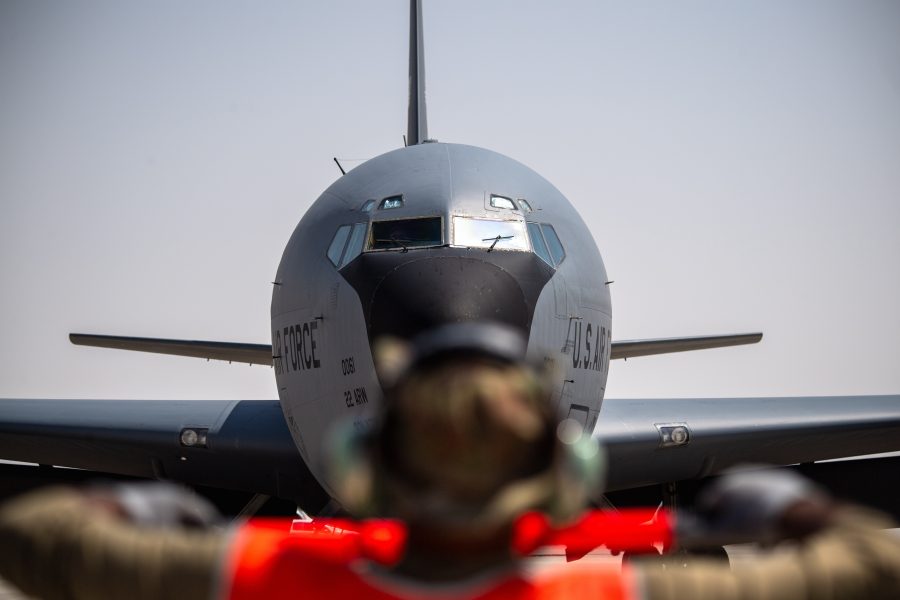Audio of this article is brought to you by the Air & Space Forces Association, honoring and supporting our Airmen, Guardians, and their families. Find out more at afa.org
The U.S. military is flexing its airpower in response to Iran and Lebanese Hezbollah’s threats to attack Israel.
The Pentagon has already highlighted the deployment of stealthy, fifth-generation fighters to the Middle East, including roughly a dozen U.S. Air Force F-22 Raptors. On Aug 11, the Defense Department said it was accelerating the deployment of the USS Abraham Lincoln aircraft carrier, which was already steaming to the region, along with embarked squadrons of Marine Corps F-35Cs. And the Pentagon has sent additional aircraft as well.
The Pentagon bolstered U.S. forces in the region after Iran vowed to avenge the July 30 killing of Hamas political leader Ismail Haniyeh in Tehran. Iran says the attack was carried out by Israel, which has not publicly claimed or denied responsibility.
U.S. troops have also come under attack in Iraq and Syria in recent weeks, with the last attack in Syria on Aug. 9 causing several injuries, according to the Pentagon. The U.S. has some 2,500 troops in Iraq and 900 in Syria.
“Are we trying to send a message? Absolutely, we’re trying to send a message which is we’re looking to de-escalate the situation, that we’re looking to have capabilities in the region to protect our forces while also supporting the defense of Israel,” Pentagon Press Secretary Air Force Maj. Gen. Patrick S. Ryder told reporters on Aug. 12. “We do not want to see this broaden into a wider regional conflict. And so those capabilities bring real capacity for the U.S. to support all of those objectives. And so however you want to interpret it, whether it’s messaging or providing additional capabilities, I think the answer is yes on all accounts as it always has been.”
The Air Force has moved to bulk up its aerial refueling tanker presence because of the increased number of fighters in the region, U.S. officials say. USAF KC-135 tankers have been spotted on open-source flight tracking websites flying over Iraq and the Persian Gulf in recent days.
Most tankers in the region appear to be operating as the 350th Expeditionary Air Refueling Squadron. KC-135 Stratotankers from Air National Guard, Air Force Reserve Command, and Active-duty units have been spotted with that unit in August including:
- KC-135s from McConnell Air Force Base, Kan, from the Active-duty 22nd Air Refueling Wing
- KC-135s from Grissom Air Reserve Base, Ind., from Air Force Reserve Command
- KC-135s from Tinker Air Force Base, Okla., from Air Force Reserve Command
- At least one KC-135 from the 100th Air Refueling Wing at RAF Mildenhall, U.K.
- At least one KC-135 from the Wisconsin Air National Guard
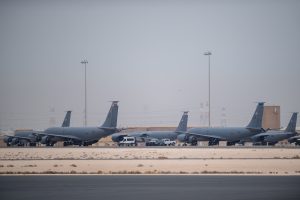
KC-135 Stratotankers assigned to the 350th Expeditionary Air Refueling Squadron are parked at an undisclosed location within the U.S. Central Command area of responsibility, Aug. 6th, 2024. The U.S. Air Force is globally postured to protect and defend freedom of coalition allies and regional partners within the CENTCOM AOR to maintain peace and stability across the region. (U.S. Air Force photo)
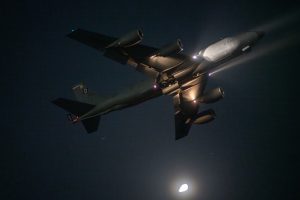
A KC-135 Stratotanker assigned to the 350th Expeditionary Air Refueling Squadron takes flight at an undisclosed location within the U.S. Central Command (USCENTCOM) area of responsibility (AOR), Aug. 13, 2024. The KC-135 is deployed to the USCENTCOM AOR as a force enabler for the Ninth Air Force (U.S. Air Forces Central). The 350th EARS provides critical air refueling capabilities to U.S. and coalition forces throughout the region, extending the U.S. Air Force’s global reach. (U.S. Air Force photo)
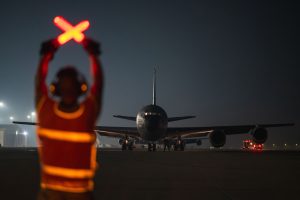
A maintainer assigned to the 350th Expeditionary Air Refueling Squadron marshals a KC-135 Stratotanker at an undisclosed location within the U.S. Central Command (USCENTCOM) area of responsibility (AOR), Aug. 13, 2024. The U.S. Air Force is globally postured to protect and defend freedom of coalition allies and regional partners within the USCENTCOM AOR to maintain peace and stability across the region. (U.S. Air Force photo)
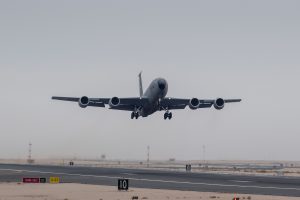
A KC-135 Stratotanker assigned to the 350th Expeditionary Air Refueling Squadron takes off from an undisclosed location within the U.S. Central Command area of responsibility, Aug. 6th, 2024. The KC-135 is deployed within the CENTCOM AOR to help defend U.S. and coalition interests, promote regional security, and deter potential adversaries in the region. (U.S. Air Force photo)
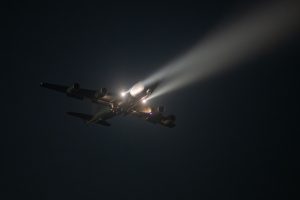
A KC-135 Stratotanker assigned to the 350th Expeditionary Air Refueling Squadron takes flight at an undisclosed location within the U.S. Central Command (USCENTCOM) area of responsibility (AOR), Aug. 13, 2024. The KC-135 is deployed to the USCENTCOM AOR as a force enabler for the Ninth Air Force (U.S. Air Forces Central). The 350th EARS provides critical air refueling capabilities to U.S. and coalition forces throughout the region, extending the U.S. Air Force’s global reach. (U.S. Air Force photo)
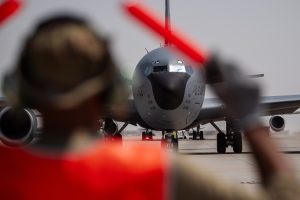
A maintainer assigned to the 350th Expeditionary Air Refueling Squadron marshals a KC-135 Stratotanker at an undisclosed location within the U.S. Central Command area of responsibility, Aug. 5th, 2024. U.S. Air Force photo)
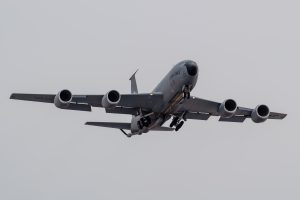
A KC-135 Stratotanker assigned to the 350th Expeditionary Air Refueling Squadron takes off from an undisclosed location within the U.S. Central Command area of responsibility, Aug. 6th, 2024. The KC-135 is deployed within the CENTCOM AOR to help defend U.S. and coalition interests, promote regional security, and deter potential adversaries in the region. (U.S. Air Force photo)
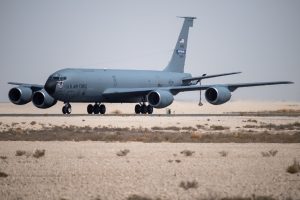
A KC-135 Stratotanker assigned to the 350th Expeditionary Air Refueling Squadron taxis after landing at an undisclosed location within the U.S. Central Command area of responsibility, Aug. 5th, 2024. The KC-135 is deployed within the CENTCOM AOR to help defend U.S. and coalition interests, promote regional security, and deter potential adversaries in the region. (U.S. Air Force photo)
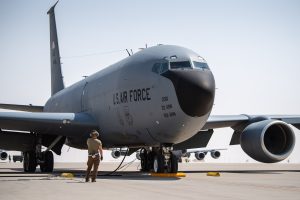
Maintainers assigned to the 350th Expeditionary Air Refueling Squadron perform a post-flight inspection on a KC-135 Stratotanker at an undisclosed location within the U.S. Central Command area of responsibility, Aug. 5th, 2024. The U.S. maintains a highly agile fighting force, which leverages the most advanced training and platforms to dominate the warfighting landscape for the long-term security and stability of the region. (U.S. Air Force photo)
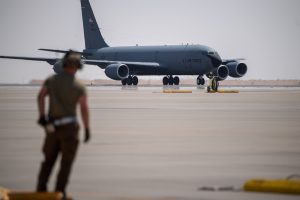
A KC-135 Stratotanker assigned to the 350th Expeditionary Air Refueling Squadron prepares to park at an undisclosed location within the U.S. Central Command area of responsibility, Aug. 5th, 2024. The KC-135 is deployed within the CENTCOM AOR to help defend U.S. and coalition interests, promote regional security, and deter potential adversaries in the region. (U.S. Air Force photo)
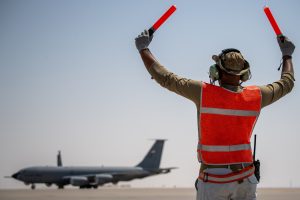
A maintainer assigned to the 350th Expeditionary Air Refueling Squadron marshals a KC-135 Stratotanker at an undisclosed location within the U.S. Central Command area of responsibility, Aug. 5th, 2024. The U.S. Air Force is globally postured to protect and defend freedom of coalition allies and regional partners within the CENTCOM AOR to maintain peace and stability across the region. (U.S. Air Force photo)
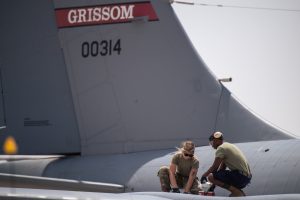
Maintainers assigned to the 350th Expeditionary Air Refueling Squadron perform maintenance on a KC-135 Stratotanker at an undisclosed location within the U.S. Central Command area of responsibility, Aug. 5th, 2024. The U.S. Air Force is globally postured to protect and defend freedom of coalition allies and regional partners within the CENTCOM AOR to maintain peace and stability across the region. (U.S. Air Force photo)
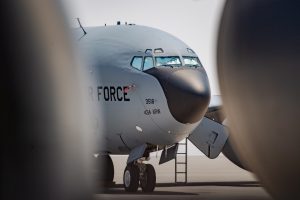
A KC-135 Stratotanker assigned to the 350th Expeditionary Air Refueling Squadron parks on the flightline at an undisclosed location within the U.S. Central Command area of responsibility, Aug. 5th, 2024. The KC-135 is deployed within the CENTCOM AOR to help defend U.S. and coalition interests, promote regional security, and deter potential adversaries in the region. (U.S. Air Force photo)
Some of those aircraft arrived in CENTCOM earlier this month, supporting the increased airpower Secretary of Defense Lloyd J. III ordered to the region on Aug. 2.
KC-135s from the 191st Expeditionary Air Refueling Squadron of the Utah Air National Guard have recently been operating in the region as well.
Around a dozen F-22s arrived at a base in the region on Aug. 8. Days earlier, roughly the same number of F/A-18s from the USS Theodore Roosevelt aircraft carrier arrived at an air base in the region in order to be closer to Israel and U.S. troops in the region. The Theodore Roosevelt was last spotted off the Gulf of Oman, where it had been operating for the last month, much farther away from the action.
The Lincoln has been ordered to “accelerate its transit to CENTCOM, adding to the capabilities already provided by the USS Theodore Roosevelt Carrier Strike Group,” Ryder told reporters Aug. 12.
The Pentagon previously said that Lincoln would replace Roosevelt when it ordered the carrier movement on Aug. 2. But the Defense Department’s Aug. 11 statement that Lincoln would be “adding to the capabilities” provided to Roosevelt raises the possibility that two carriers might simultaneously operate in the region.
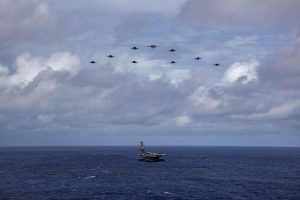
240802-N-NH911-2193 PACIIFIC OCEAN (Aug. 2, 2024) Aircraft assigned to Carrier Airwing 9, fly over the Nimitz-class aircraft carrier USS Abraham Lincoln (CVN 72) sails in the Pacific Ocean. Abraham Lincoln, flagship of Carrier Strike Group Three, is underway conducting routine operations in the U.S. 7th Fleet area of operations. U.S. 7th Fleet is the U.S. Navy’s largest forward-deployed numbered fleet, and routinely interacts and operates with allies and partners in preserving a free and open Indo-Pacific region. (U.S. Navy photo by Mass Communication Specialist Seaman Apprentice Daniel Kimmelman)
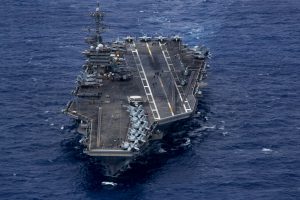
240802-N-NH911-1941 PACIIFIC OCEAN (Aug. 2, 2024) The Nimitz-class aircraft carrier USS Abraham Lincoln (CVN 72) sails in the Pacific Ocean. Abraham Lincoln, flagship of Carrier Strike Group Three, is underway conducting routine operations in the U.S. 7th Fleet area of operations. U.S. 7th Fleet is the U.S. Navy’s largest forward-deployed numbered fleet, and routinely interacts and operates with allies and partners in preserving a free and open Indo-Pacific region. (U.S. Navy photo by Mass Communication Specialist Seaman Apprentice Daniel Kimmelman)
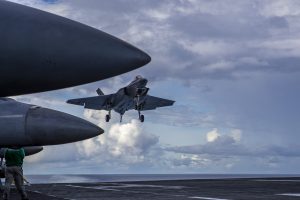
240810-N-NH911-1169 PACIFIC OCEAN (Aug. 10, 2024) An F-35C Lightning II, assigned to Marine Fighter Attack Squadron (VMFA) 314, prepares to make an arrested landing on the flight deck of the Nimitz-class aircraft carrier USS Abraham Lincoln (CVN 72). Abraham Lincoln, flagship of Carrier Strike Group Three, is underway conducting routine operations in the U.S. 7th Fleet area of operations. U.S. 7th Fleet is the U.S. Navy’s largest forward-deployed numbered fleet, and routinely interacts and operates with allies and partners in preserving a free and open Indo-Pacific region. (U.S. Navy photo by Mass Communication Specialist Seaman Apprentice Daniel Kimmelman)
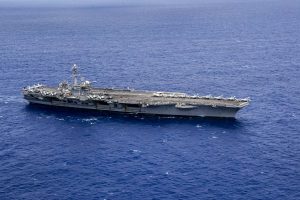
240802-N-NH911-2030 PACIIFIC OCEAN (Aug. 2, 2024) The Nimitz-class aircraft carrier USS Abraham Lincoln (CVN 72) sails in the Pacific Ocean. Abraham Lincoln, flagship of Carrier Strike Group Three, is underway conducting routine operations in the U.S. 7th Fleet area of operations. U.S. 7th Fleet is the U.S. Navy’s largest forward-deployed numbered fleet, and routinely interacts and operates with allies and partners in preserving a free and open Indo-Pacific region. (U.S. Navy photo by Mass Communication Specialist Seaman Apprentice Daniel Kimmelman)
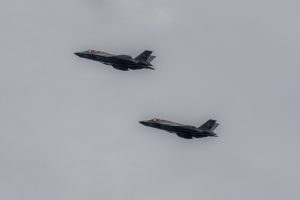
240801-N-NH911-1260 PACIFIC OCEAN (August 1, 2024) Two F-35C Lightning IIs, assigned to Marine Fighter Attack Squadron (VMFA) 314, fly by the Nimitz-class aircraft carrier USS Abraham Lincoln (CVN 72). Abraham Lincoln, flagship of Carrier Strike Group Three, is underway conducting routine operations in the U.S. 7th Fleet area of operations. U.S. 7th Fleet is the U.S. Navy’s largest forward-deployed numbered fleet, and routinely interacts and operates with allies and partners in preserving a free and open Indo-Pacific region. (U.S. Navy photo by Mass Communication Specialist Seaman Apprentice Daniel Kimmelman)
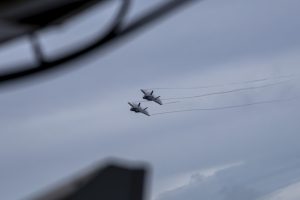
240801-N-NH911-1260 PACIFIC OCEAN (August 1, 2024) Two F-35C Lightning IIs, assigned to Marine Fighter Attack Squadron (VMFA) 314, fly by the Nimitz-class aircraft carrier USS Abraham Lincoln (CVN 72). Abraham Lincoln, flagship of Carrier Strike Group Three, is underway conducting routine operations in the U.S. 7th Fleet area of operations. U.S. 7th Fleet is the U.S. Navy’s largest forward-deployed numbered fleet, and routinely interacts and operates with allies and partners in preserving a free and open Indo-Pacific region. (U.S. Navy photo by Mass Communication Specialist Seaman Apprentice Daniel Kimmelman)
On Aug. 13, Ryder told reporters the Lincoln is “going to move with all haste to get to the [Middle East] to provide this additional capability and capacity.” He declined to say whether the two carriers would operate in the Middle East at the same time. The amphibious assault ship USS Wasp, which is carrying some AV-8 Harrier fixed-wing warplanes, is in the Mediterranean Sea.
The U.S. has four Air Force fighter squadrons in the region in addition to the Navy fighters and incoming Marine Corps F-35s:
- F-22s from the 90th Fighter Squadron deployed from Joint Base Emendorf-Richardson, Alaska.
- F-15Es from the 335th Fighter Squadron deployed from Seymour Johnson Air Force Base, N.C.
- F-16s from the 510th Fighter Squadron deployed from Aviano Air Base, Italy.
- A-10s from the 107th Fighter Squadron at Selfridge Air National Guard Base, Mich.
Cargo aircraft have also continued to conduct missions in the Middle East, though it is unclear if there are more airlifters based in the region. The U.S. has some 30,000 troops deployed across CENTCOM, according to the Pentagon.
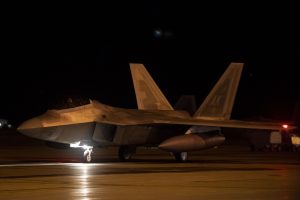
A U.S. Air Force F-22 Raptor assigned to the 90th Fighter Squadron, 3rd Wing, prepares to deploy to the U.S. Central Command area of responsibility at Joint Base Elmendorf-Richardson, Alaska, Aug. 6, 2024. U.S. Air Force photo by Senior Airman Julia Lebens
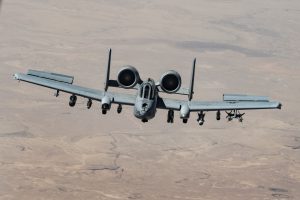
A U.S. Air Force A-10 Thunderbolt II from Selfridge Air National Guard Base’s 107th Expeditionary Fighter Squadron flies over an undisclosed location within the U.S. Central Command (USCENTCOM) area of responsibility (AOR), July 22, 2024. Members of the 107th Fighter Squadron are deployed to the USCENTCOM AOR to support regional security and stability. (U.S. Air Force photo) 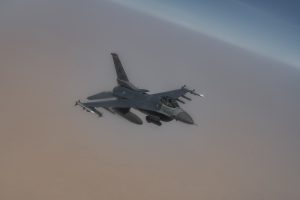
A U.S. Air Force F-16 Fighting Falcon from Aviano Air BaseÕs 510th Expeditionary Fighter Squadron departs after receiving fuel from a KC-135 Stratotanker from Fairchild Air Force BaseÕs 92nd Expeditionary Air Refueling Squadron over the U.S. Central Command area of responsibility, June 26, 2024. Members of the 510th EFS are deployed to the CENTCOM area of responsibility in support of operations for regional security and stability such as free trade initiatives in the Red Sea. (U.S. Air Force photo) 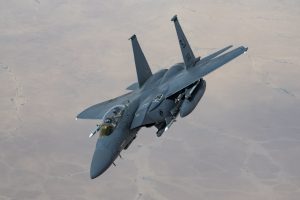
A U.S. Air Force F-15E Strike Eagle from Seymour-Johnson Air Force BaseÕs 335th Fighter Squadron breaks off after receiving fuel from a KC-135 Stratotanker from the Tennessee Air National GuardÕs 151st Air Refueling Squadron, over the U.S. Central Command area of responsibility, April 20, 2024. The F-15 is deployed within the CENTCOM area of responsibility to help defend U.S. interests and coalition interests, promote regional security, and deter potential adversaries in the region. (U.S. Air Force Photo) Austin also ordered the Ohio-class submarine USS Georgia to CENTCOM, the Pentagon said Aug. 11 in a rare disclosure of submarine movements. The Georgia carries over 150 Tomahawk land attack cruise missiles. The USS Florida, another Ohio-class guided-missile submarine, recently concluded a two-year deployment during which it fired Tomahawks at Houthi targets in Yemen earlier this year.
“The thing about the U.S. military, as you’re seeing this week, is that we have the ability to surge forces and capabilities to where we need them when we need them,” Ryder said Aug. 13.
Audio of this article is brought to you by the Air & Space Forces Association, honoring and supporting our Airmen, Guardians, and their families. Find out more at afa.org
